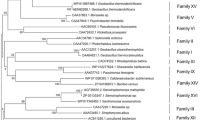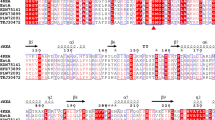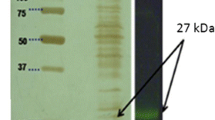Abstract
The gene encoding carboxylesterase from the hyperthermophilic bacterium Thermotoga maritima (tm0053) was cloned. The recombinant protein (EST53) was overexpressed in Escherichia coli without its NH2-terminal hydrophobic region, and with a C-terminal hexahistidine sequence. The enzyme was purified to homogeneity by heat treatment, followed by Ni2+ affinity chromatography, and then characterized. Among the p-nitrophenyl esters tested, the best substrate was p-nitrophenyl decanoate with K m and k cat values of 3.1 μM and 10.8 s−1, respectively, at 60°C and pH 7.5. The addition of O,O′-bis(2-aminoethyl)ethyleneglycol-N,N,N′,N′-tetraacetic acid decreased the esterase activity, indicating that EST53 is dependent on the presence of Ca2+ ion. In addition, its activity was inhibited by the addition of phenylmethylsulfonyl fluoride and diethyl pyrocarbonate, indicating that it contains serine and histidine residues, which play key roles in the catalytic mechanism. EST53 shows a relatively high degree of similarity to Burkholderia lipases that belong to family I.2 of the lipolytic enzymes, whereas the local sequence around the pentapeptide of EST53 is most similar to those of Bacillus lipases belonging to family I.4.



Similar content being viewed by others
References
Arpigny JL, Jaeger KE (1999) Bacterial lipolytic enzymes: classification and properties. Biochem J 343:177–183
Bendtsen JD, Nielsen H, von Heijne G, Brunak S (2004) Improved prediction of signal peptides: SignalP 3.0. J Mol Biol 340:783–795
Franken SM, Rozeboom HJ, Kalk KH, Dijkstra BW (1991) Crystal structure of haloalkane dehalogenase: an enzyme to detoxify halogenated alkanes. EMBO J 10:1297–1302
Frenken LG, Bos JW, Visser C, Muller W, Tommassen J, Verrips CT (1993a) An accessory gene, lipB, required for the production of active Pseudomonas glumae lipase. Mol Microbiol 9:579–589
Frenken LG, de Groot A, Tommassen J, Verrips CT (1993b) Role of the lipB gene product in the folding of the secreted lipase of Pseudomonas glumae. Mol Microbiol 9:591–599
Fushinobu S, Jun SY, Hidaka M, Nojiri H, Yamane H, Shoun H, Omori T, Wakagi T (2005) A series of crystal structures of a meta-cleavage product hydrolase from Pseudomonas fluorescens IP01 (CumD) complexed with various cleavage products. Biosci Biotechnol Biochem 69:491–498
Hotta Y, Ezaki S, Atomi H, Imanaka T (2002) Extremely stable and versatile carboxylesterase from a hyperthermophilic archaeon. Appl Environ Microbiol 68:3925–3931
Jaeger KE, Reetz MT (1998) Microbial lipases form versatile tools for biotechnology. Trends Biotechnol 16:396–403
Jaeger KE, Dijkstra BW, Reetz MT (1999) Bacterial biocatalysts: molecular biology, three-dimensional structures, and biotechnological applications of lipases. Annu Rev Microbiol 53:315–351
Laemmli UK (1970) Cleavage of structural proteins during the assembly of the head of bacteriophage T4. Nature 227:680–685
Lang D, Hofmann B, Haalck L, Hecht HJ, Spener F, Schmid RD, Schomburg D (1996) Crystal structure of a bacterial lipase from Chromobacterium viscosum ATCC 6918 refined at 1.6 angstroms resolution. J Mol Biol 259:704–717
Liao DI, Remington SJ (1990) Structure of wheat serine carboxypeptidase II at 3.5-Å resolution. A new class of serine proteinase. J Biol Chem 265:6528–6531
Manco G, Giosue E, D’Auria S, Herman P, Carrea G, Rossi M (2000) Cloning, overexpression, and properties of a new thermophilic and thermostable esterase with sequence similarity to hormone-sensitive lipase subfamily from the archaeon Archaeoglobus fulgidus. Arch Biochem Biophys 373:182–192
Mandrich L, Merone L, Pezzullo M, Cipolla L, Nicotra F, Rossi M, Manco G (2005) Role of the N terminus in enzyme activity, stability and specificity in thermophilic esterases belonging to the HSL family. J Mol Biol 345:501–512
Morana A, Di Prizito N, Aurilia V, Rossi M, Cannio R (2002) A carboxylesterase from the hyperthermophilic archaeon Sulfolobus solfataricus: cloning of the gene, characterization of the protein. Gene 283:107–115
Nardini M, Lang DA, Liebeton K, Jaeger KE, Dijkstra BW (2000) Crystal structure of Pseudomonas aeruginosa lipase in the open conformation. The prototype for family I.1 of bacterial lipases. J Biol Chem 275:31219–31225
Noble ME, Cleasby A, Johnson LN, Egmond MR, Frenken LG (1993) The crystal structure of triacylglycerol lipase from Pseudomonas glumae reveals a partially redundant catalytic aspartate. FEBS Lett 331:123–128
Ollis DL, Cheah E, Cygler M, Dijkstra B, Frolow F, Franken SM, Harel M, Remington SJ, Silman I, Schrag J et al (1992) The alpha/beta hydrolase fold. Protein Eng 5:197–211
Park OJ, Lee SH (2005) Stereoselective lipases from Burkholderia sp., cloning and their application to preparation of methyl (R)-N-(2,6-dimethylphenyl)alaninate, a key intermediate for (R)-Metalaxyl. J Biotechnol 120:174–182
Pathak D, Ollis D (1990) Refined structure of dienelactone hydrolase at 1.8 Å. J Mol Biol 214:497–525
Rashid N, Shimada Y, Ezaki S, Atomi H, Imanaka T (2001) Low-temperature lipase from psychrotrophic Pseudomonas sp. strain KB700A. Appl Environ Microbiol 67:4064–4069
Schrag JD, Li Y, Cygler M, Lang D, Burgdorf T, Hecht HJ, Schmid R, Schomburg D, Rydel TJ, Oliver JD, Strickland LC, Dunaway CM, Larson SB, Day J, McPherson A (1997) The open conformation of a Pseudomonas lipase. Structure 5:187–202
Simons JW, van Kampen MD, Ubarretxena-Belandia I, Cox RC, Alves dos Santos CM, Egmond MR, Verheij HM (1999) Identification of a calcium binding site in Staphylococcus hyicus lipase: generation of calcium-independent variants. Biochemistry (Mosc) 38:2–10
Sussman JL, Harel M, Frolow F, Oefner C, Goldman A, Toker L, Silman I (1991) Atomic structure of acetylcholinesterase from Torpedo californica: a prototypic acetylcholine-binding protein. Science 253:872–879
Thompson JD, Higgins DG, Gibson TJ (1994) CLUSTAL W: improving the sensitivity of progressive multiple sequence alignment through sequence weighting, position-specific gap penalties and weight matrix choice. Nucleic Acids Res 22:4673–4680
Author information
Authors and Affiliations
Corresponding author
Rights and permissions
About this article
Cite this article
Kakugawa, S., Fushinobu, S., Wakagi, T. et al. Characterization of a thermostable carboxylesterase from the hyperthermophilic bacterium Thermotoga maritima . Appl Microbiol Biotechnol 74, 585–591 (2007). https://doi.org/10.1007/s00253-006-0687-9
Received:
Revised:
Accepted:
Published:
Issue Date:
DOI: https://doi.org/10.1007/s00253-006-0687-9




